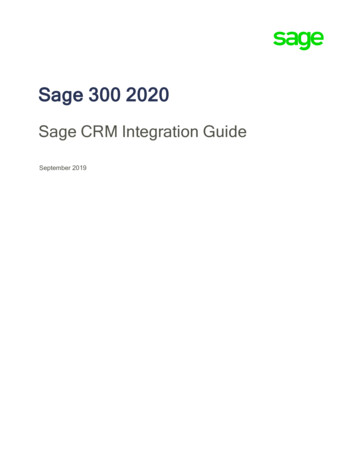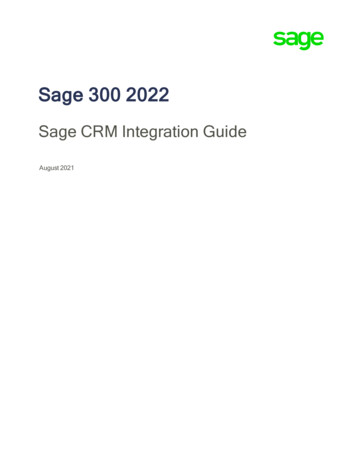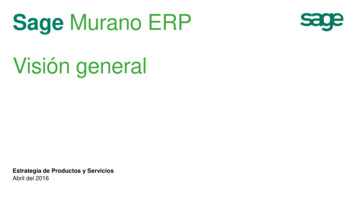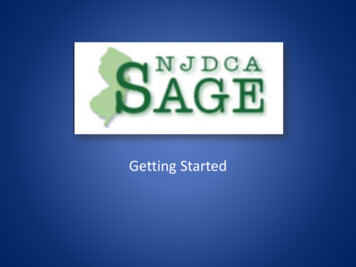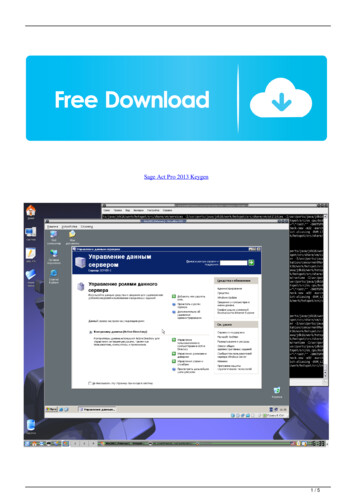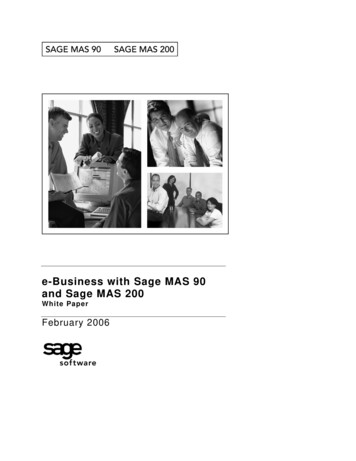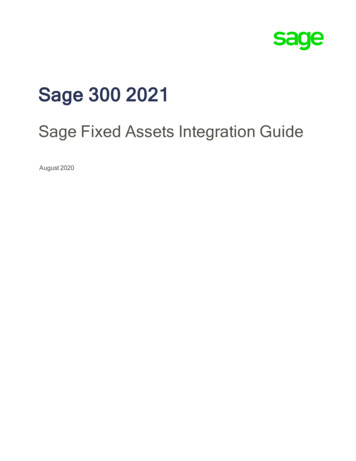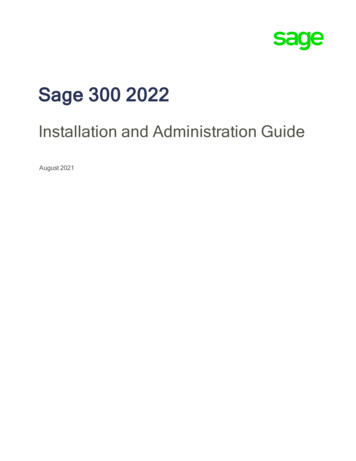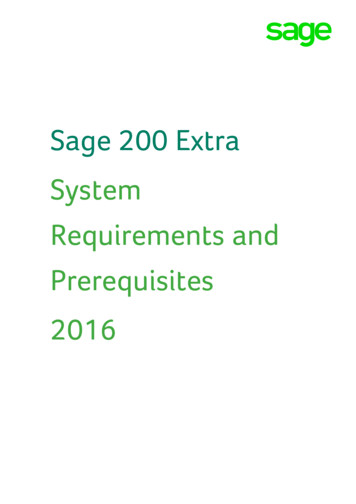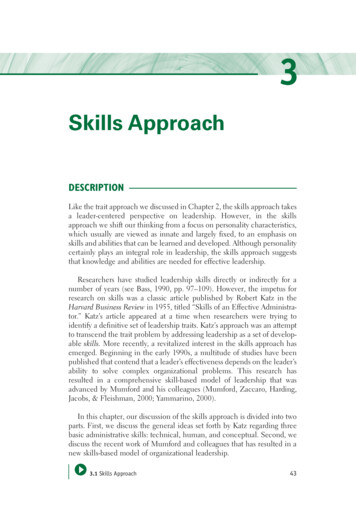
Transcription
3Skills ApproachDESCRIPTIONLike the trait approach we discussed in Chapter 2, the skills approach takesa leader-centered perspective on leadership. However, in the skillsapproach we shift our thinking from a focus on personality characteristics,which usually are viewed as innate and largely fixed, to an emphasis onskills and abilities that can be learned and developed. Although personalitycertainly plays an integral role in leadership, the skills approach suggeststhat knowledge and abilities are needed for effective leadership.Researchers have studied leadership skills directly or indirectly for anumber of years (see Bass, 1990, pp. 97–109). However, the impetus forresearch on skills was a classic article published by Robert Katz in theHarvard Business Review in 1955, titled “Skills of an Effective Administrator.” Katz’s article appeared at a time when researchers were trying toidentify a definitive set of leadership traits. Katz’s approach was an attemptto transcend the trait problem by addressing leadership as a set of developable skills. More recently, a revitalized interest in the skills approach hasemerged. Beginning in the early 1990s, a multitude of studies have beenpublished that contend that a leader’s effectiveness depends on the leader’sability to solve complex organizational problems. This research hasresulted in a comprehensive skill-based model of leadership that wasadvanced by Mumford and his colleagues (Mumford, Zaccaro, Harding,Jacobs, & Fleishman, 2000; Yammarino, 2000).In this chapter, our discussion of the skills approach is divided into twoparts. First, we discuss the general ideas set forth by Katz regarding threebasic administrative skills: technical, human, and conceptual. Second, wediscuss the recent work of Mumford and colleagues that has resulted in anew skills-based model of organizational leadership.3.1 Skills Approach43
44 LEADERSHIPTHEORY AND PRACTICEThree-Skill ApproachBased on field research in administration and his own firsthand observations of executives in the workplace, Katz (1955, p. 34) suggested thateffective administration (i.e., leadership) depends on three basic personalskills: technical, human, and conceptual. Katz argued that these skills arequite different from traits or qualities of leaders. Skills are what leaders canaccomplish, whereas traits are who leaders are (i.e., their innate characteristics). Leadership skills are defined in this chapter as the ability to useone’s knowledge and competencies to accomplish a set of goals or objectives. This chapter shows that these leadership skills can be acquired andleaders can be trained to develop them.Technical SkillTechnical skill is knowledge about and proficiency in a specific type ofwork or activity. It includes competencies in a specialized area, analyticalability, and the ability to use appropriate tools and techniques (Katz, 1955).For example, in a computer software company, technical skill mightinclude knowing software language and programming, the company’ssoftware products, and how to make these products function for clients.Similarly, in an accounting firm, technical skill might include understanding and having the ability to apply generally accepted accounting principles to a client’s audit. In both these examples, technical skills involve ahands-on activity with a basic product or process within an organization.Technical skills play an essential role in producing the actual products acompany is designed to produce.As illustrated in Figure 3.1, technical skill is most important at lowerand middle levels of management and less important in upper management. For leaders at the highest level, such as chief executive officers(CEOs), presidents, and senior officers, technical competencies are not asessential. Individuals at the top level depend on skilled subordinates tohandle technical issues of the physical operation.Human SkillHuman skill is knowledge about and ability to work with people. It isquite different from technical skill, which has to do with working withthings (Katz, 1955). Human skills are “people skills.” They are the abilitiesthat help a leader to work effectively with subordinates, peers, and superiors3.1 Evidence-Based Practice3.2 Colin Powell
Chapter 3 Skills Approach 45to accomplish the organization’s goals. Human skills allow a leader to assistgroup members in working cooperatively as a group to achieve commongoals. For Katz, it means being aware of one’s own perspective on issuesand, at the same time, being aware of the perspective of others. Leaders withhuman skills adapt their own ideas to those of others. Furthermore, theycreate an atmosphere of trust where employees can feel comfortable andsecure and where they can feel encouraged to become involved in the planning of things that will affect them. Being a leader with human skills meansbeing sensitive to the needs and motivations of others and taking intoaccount others’ needs in one’s decision making. In short, human skill is thecapacity to get along with others as you go about your work.In Figure 3.1, human skills are important in all three levels of management. Although managers at lower levels may communicate with a farFigure 3.1 Management Skills Necessary at Various Levels of anOrganizationSKILLS mentTECHNICALHUMANCONCEPTUALSOURCE: Adapted from “Skills of an Effective Administrator,” by R. L. Katz, 1955,Harvard Business Review, 33(1), pp. 33–42.
46 LEADERSHIPTHEORY AND PRACTICEgreater number of employees, human skills are equally important atmiddle and upper levels.Conceptual SkillBroadly speaking, conceptual skills are the ability to work with ideasand concepts. Whereas technical skills deal with things and human skillsdeal with people, conceptual skills involve the ability to work with ideas. Aleader with conceptual skills is comfortable talking about the ideas thatshape an organization and the intricacies involved. He or she is good atputting the company’s goals into words and can understand and expressthe economic principles that affect the company. A leader with conceptualskills works easily with abstractions and hypothetical notions.Conceptual skills are central to creating a vision and strategic plan foran organization. For example, it would take conceptual skills for a CEO ina struggling manufacturing company to articulate a vision for a line of newproducts that would steer the company into profitability. Similarly, itwould take conceptual skill for the director of a nonprofit health organization to create a strategic plan that could compete successfully with forprofit health organizations in a market with scarce resources. The point ofthese examples is that conceptual skill has to do with the mental work ofshaping the meaning of organizational or policy issues—understandingwhat a company stands for and where it is or should be going.In Figure 3.1, conceptual skill is most important at the top management levels. In fact, when upper-level managers do not have strong conceptual skills, they can jeopardize the whole organization. Conceptualskills are also important in middle management; as we move down to lowermanagement levels, conceptual skills become less important.Summary of the Three-Skill ApproachTo summarize, the three-skill approach includes technical, human, andconceptual skills. It is important for leaders to have all three skills; depending on where they are in the management structure, however, some skillsare more important than others are.Katz’s work in the mid-1950s set the stage for conceptualizingleadership in terms of skills, but it was not until the mid-1990s that an
Chapter 3 Skills Approach 47empirically-based skills approach received recognition in leadershipresearch. In the next section, the comprehensive skill-based model of leadership is presented.Skills ModelBeginning in the early 1990s, a group of researchers, with funding fromthe U.S. Army and Department of Defense, set out to test and develop acomprehensive theory of leadership based on problem-solving skills inorganizations. The studies were conducted over a number of years using asample of more than 1,800 Army officers, representing six grade levels,from second lieutenant to colonel. The project used a variety of new measures and tools to assess the skills of these officers, their experiences, andthe situations in which they worked.The researchers’ main goal was to explain the underlying elements ofeffective performance. They addressed questions such as these: Whataccounts for why some leaders are good problem solvers and others arenot? What specific skills do high-performing leaders exhibit? How do leaders’individual characteristics, career experiences, and environmental influences affect their job performance? As a whole, researchers wanted toidentify the leadership factors that create exemplary job performance in anactual organization.Based on the extensive findings from the project, Mumford and colleagues formulated a skill-based model of leadership. The model is characterized as a capability model because it examines the relationshipbetween a leader’s knowledge and skills (i.e., capabilities) and the leader’sperformance (Mumford, Zaccaro, Harding, et al., 2000, p. 12). Leadershipcapabilities can be developed over time through education and experience. Unlike the “great man” approach (discussed in this text, Chapter 2),which implies that leadership is reserved for only the gifted few, the skillsapproach suggests that many people have the potential for leadership. Ifpeople are capable of learning from their experiences, they can acquireleadership. The skills approach can also be distinguished from the leadership approaches we will discuss in subsequent chapters, which focus onbehavioral patterns of leaders (e.g., the style approach, transformationalleadership, or leader–member exchange theory). Rather than emphasizingwhat leaders do, the skills approach frames leadership as the capabilities(knowledge and skills) that make effective leadership possible (Mumford,Zaccaro, Harding, et al., 2000, p. 12).3.1 Conceptualizations of Skill3.2 Leadership Development
48 LEADERSHIPTHEORY AND PRACTICEThe skill-based model of Mumford’s group has five components: competencies, individual attributes, leadership outcomes, career experiences,and environmental influences. A portion of the model, illustrating three ofthese components, appears in Figure 3.2. This portion of the model isessential to understanding the overall skill-based leadership model.Figure 3.2 Three Components of the Skills ModelINDIVIDUALATTRIBUTESCOMPETENCIESGeneral CognitiveAbilityProblem-SolvingSkillsCrystallized CognitiveAbilityMotivationSocial ESEffectiveProblem SolvingPerformanceSOURCE: Adapted from “Leadership Skills for a Changing World: Solving ComplexSocial Problems,” by M. D. Mumford, S. J. Zaccaro, F. D. Harding, T. O. Jacobs, andE. A. Fleishman, 2000, Leadership Quarterly, 11(1), 23.CompetenciesAs can be observed in the middle box in Figure 3.2, problem-solvingskills, social judgment skills, and knowledge are at the heart of the skillsmodel. These three competencies are the key factors that account for effective performance.Problem-Solving Skills. What are problem-solving skills? According toMumford, Zaccaro, Harding, et al. (2000), problem-solving skills are aleader’s creative ability to solve new and unusual, ill-defined organizationalproblems. The skills include being able to define significant problems,gather problem information, formulate new understandings about theproblem, and generate prototype plans for problem solutions. These skillsdo not function in a vacuum, but are carried out in an organizationalcontext. Problem-solving skills demand that leaders understand their ownleadership capacities as they apply possible solutions to the unique problems in their organization (Mumford, Zaccaro, Connelly, & Marks, 2000).3.2 Problem-Solving Approaches3.3 Decision Making
Chapter 3 Skills Approach 49Being able to construct solutions plays a special role in problem solving.In considering solutions to organizational problems, skilled leaders need toattend to the time frame for constructing and implementing a solution,short-term and long-term goals, career goals and organizational goals, andexternal issues, all of which could influence the solution (Mumford,Zaccaro, Harding, et al., 2000, p. 15).To clarify what is meant by problem-solving skills, consider the following hypothetical situation. Imagine that you are the director of humanresources for a medium-sized company and you have been informed bythe president that you have to develop a plan to reduce the company’shealth care costs. In deciding what you will do, you could demonstrateproblem-solving skills in the following ways. First, you identify the fullramifications for employees of changing their health insurance coverage.What is the impact going to be? Second, you gather information abouthow benefits can be scaled back. What other companies have attempted asimilar change, and what were their results? Third, you find a way to teachand inform the employees about the needed change. How can you framethe change in such a way that it is clearly understood? Fourth, you createpossible scenarios for how the changes will be instituted. How will the planbe described? Fifth, you look closely at the solution itself. How will implementing this change affect the company’s mission and your own career?Last, are there issues in the organization (e.g., union rules) that may affectthe implementation of these changes?As illustrated by this example, the process of dealing with novel,ill-defined organizational problems is complex and demanding for leaders. Inmany ways, it is like a puzzle to be solved. For leaders to solve such puzzles, the skill-based model suggests that problem-solving skills are essential.Social Judgment Skills. In addition to problem-solving skills, effective leadership performance also requires social judgment skills (see Figure 3.2). Ingeneral, social judgment skills are the capacity to understand people andsocial systems (Zaccaro, Mumford, Connelly, Marks, & Gilbert, 2000,p. 46). They enable leaders to work with others to solve problems and tomarshal support to implement change within an organization. Socialjudgment skills are the people skills that are necessary to solve uniqueorganizational problems.Conceptually, social judgment skills are similar to Katz’s (1955) earlywork on the role of human skills in management. In contrast to Katz’swork, Mumford and colleagues have delineated social judgment skills into3.4 Flexibility
50 LEADERSHIPTHEORY AND PRACTICEthe following: perspective taking, social perceptiveness, behavioral flexibility, and social performance.Perspective taking means understanding the attitudes that others havetoward a particular problem or solution. It is empathy applied to problemsolving. Perspective taking means being sensitive to other people’s perspectives and goals—being able to understand their point of view on differentissues. Included in perspective taking is knowing how different constituencies in an organization view a problem and possible solutions. Accordingto Zaccaro, Gilbert, Thor, and Mumford (1991), perspective-taking skillscan be likened to social intelligence. These skills are concerned withknowledge about people, the social fabric of organizations, and the interrelatedness of each of them.Social perceptiveness is insight and awareness into how others in theorganization function. What is important to others? What motivates them?What problems do they face, and how do they react to change? Socialperceptiveness means understanding the unique needs, goals, and demandsof different organizational constituencies (Zaccaro et al., 1991). A leaderwith social perceptiveness has a keen sense of how employees will respondto any proposed change in the organization. In a sense, you could say itallows the leader to know the pulse of employees on any issue at any time.In addition to understanding others accurately, social judgment skills alsoinvolve reacting to others with flexibility. Behavioral flexibility is the capacityto change and adapt one’s behavior in light of an understanding of others’perspectives in the organization. Being flexible means one is not locked intoa singular approach to a problem. One is not dogmatic but rather maintainsan openness and willingness to change. As the circumstances of a situationchange, a flexible leader changes to meet the new demands.Social performance includes a wide range of leadership competencies.Based on an understanding of employees’ perspectives, leaders need to beable to communicate their own vision to others. Skill in persuasion andcommunicating change is essential to do this. When there is resistance tochange or interpersonal conflict about change, leaders need to function asmediators. To this end, skill in conflict resolution is an important aspect ofsocial performance competency. In addition, social performance sometimes requires that leaders coach subordinates, giving them direction andsupport as they move toward selected organizational goals. In all, socialperformance includes many related skills that may come under theumbrella of communication.3.3 Managerial Leadership
Chapter 3 Skills Approach 51To review, social judgment skills are about being sensitive to how yourideas fit in with others. Can you understand others’ perspectives and theirunique needs and motivations? Are you flexible, and can you adapt yourown ideas to others? Can you work with others even when there is resistance and conflict? Social judgment skills are the people skills needed toadvance change in an organization.Knowledge. As shown in the model (see Figure 3.2), the third aspect ofcompetencies is knowledge. Knowledge is inextricably related to the application and implementation of problem-solving skills in organizations. Itdirectly influences a leader’s capacity to define complex organizationalproblems and to attempt to solve them (Mumford, Zaccaro, Harding, et al.,2000). Knowledge is the accumulation of information and the mentalstructures used to organize that information. Such a mental structure iscalled a schema (a summary, a diagrammatic representation, or an outline). Knowledge results from having developed an assortment of complexschemata for learning and organizing data.For example, all of us take various kinds of facts and information intoour minds. As we organize that information into categories or schemata,the information becomes more meaningful. Knowledge emerges from thefacts and the organizational structures we apply to them. People with a lotof knowledge have more complex organizing structures than those withless knowledge. These knowledgeable people are called experts.Consider the following baseball example. A baseball expert knows a lotof facts about the game; the expert knows the rules, strategies, equipment,players, and much, much more. The expert’s knowledge about baseballincludes the facts, but it also includes the complex mental structures usedin organizing and structuring those facts. That person knows not only theseason and lifetime statistics for each player, but also that player’s quirksand injuries, the personality of the manager, the strengths and weaknessesof available substitutes, and so on. The expert knows baseball because sheor he comprehends the complexities and nuances of the game. The sameis true for leadership in organizations. Leaders with knowledge knowmuch about the products, the tasks, the people, the organization, and allthe different ways these elements are related to each other. A knowledgeable leader has many mental structures with which to organize the factsof organizational life.Knowledge has a positive impact on how leaders engage in problemsolving. It is knowledge and expertise that make it possible for people to3.5 Motivation and Leadership Styles
52 LEADERSHIPTHEORY AND PRACTICEthink about complex system issues and identify possible strategies forappropriate change. Furthermore, this capacity allows people to use priorcases and incidents in order to plan for needed change. It is knowledge thatallows people to use the past to constructively confront the future.To summarize, the skills model consists of three competencies: problemsolving skills, social judgment skills, and knowledge. Collectively, thesethree components are positively related to effective leadership performance(see Figure 3.2).Individual AttributesReturning to Figure 3.2, the box on the left identifies four individualattributes that have an impact on leadership skills and knowledge: generalcognitive ability, crystallized cognitive ability, motivation, and personality.These attributes play important roles in the skills model. Complex problem solving is a very difficult process and becomes more difficult as peoplemove up in the organization. These attributes support people as they applytheir leadership competencies.General Cognitive Ability. General cognitive ability can be thought of as aperson’s intelligence. It includes perceptual processing, information processing, general reasoning skills, creative and divergent thinking capacities, and memory skills. General cognitive ability is linked to biology, notto experience.General cognitive ability is sometimes described as fluid intelligence,a type of intelligence that usually grows and expands up through earlyadulthood and then declines with age. In the skills model, intelligence isdescribed as having a positive impact on the leader’s acquisition of complex problem-solving skills and the leader’s knowledge.Crystallized Cognitive Ability. Crystallized cognitive ability is intellectualability that is learned or acquired over time. It is the store of knowledgewe acquire through experience. We learn and increase our capacities overa lifetime, increasing our leadership potential (e.g., problem-solvingskills, conceptual ability, and social judgment skills). In normally functioning adults, this type of cognitive ability grows continuously and typically does not fall off in adulthood. It includes being able to comprehendcomplex information and learn new skills and information, as well asbeing able to communicate to others in oral and written forms (Connelly3.1 Global Leaders
Chapter 3 Skills Approach 53et al., 2000, p. 71). Stated another way, crystallized cognitive ability isacquired intelligence: the ideas and mental abilities people learn throughexperience. Because it stays fairly stable over time, this type of intelligence is not diminished as people get older.Motivation. Motivation is listed as the third attribute in the model.Although the model does not purport to explain the many ways in whichmotivation may affect leadership, it does suggest three aspects of motivation that are essential to developing leadership skills (Mumford, Zaccaro,Harding, et al., 2000, p. 22): First, leaders must be willing to tackle complex organizational problems. This first step is critical. For leadership tooccur, a person wants to lead. Second, leaders must be willing to expressdominance—to exert their influence, as we discussed in Chapter 2. Ininfluencing others, the leader must take on the responsibility of dominance because the influence component of leadership is inextricablybound to dominance. Third, leaders must be committed to the social goodof the organization. The social good is a broad term that can refer to a hostof outcomes. However, in the skills model it refers to the leader’s willingness to take on the responsibility of trying to advance the overall humangood and value of the organization. Taken together, these three aspects ofmotivation (willingness, dominance, and social good) prepare people tobecome leaders.Personality. Personality is the fourth individual attribute in the skills model.Placed where it is in the model, this attribute reminds us that our personality has an impact on the development of our leadership skills. For example,openness, tolerance for ambiguity, and curiosity may affect a leader’s motivation to try to solve some organizational problem. Or, in conflict situations, traits such as confidence and adaptability may be beneficial to aleader’s performance. The skills model hypothesizes that any personalitycharacteristic that helps people to cope with complex organizational situations probably is related to leader performance (Mumford, Zaccaro,Harding, et al., 2000).Leadership OutcomesIn the right-hand box in Figure 3.2, effective problem solving and performance are the outcomes of leadership. These outcomes are stronglyinfluenced by the leader’s competencies (i.e., problem-solving skills, socialjudgment skills, and knowledge). When leaders exhibit these competencies,they increase their chances of problem solving and overall performance.3.3 Mentoring and Coaching
54 LEADERSHIPTHEORY AND PRACTICEEffective Problem Solving. As we discussed earlier, the skills model is a capability model, designed to explain why some leaders are good problem solvers and others are not. Problem solving is the keystone in the skillsapproach. In the model (see Figure 3.2), problem-solving skills, as competencies, lead to effective problem solving as a leadership outcome. Thecriteria for good problem solving are determined by the originality and thequality of expressed solutions to problems. Good problem solving involvescreating solutions that are logical, effective, and unique, and that gobeyond given information (Zaccaro et al., 2000).Performance. In the model, performance outcomes reflect how well theleader has done her or his job. To measure performance, standard externalcriteria are used. If the leader has done well and been successful, theleader’s evaluations will be positive. Leaders who are effective receive goodannual performance reviews, get merit raises, and are recognized by superiors and subordinates as competent leaders. In the end, performance is thedegree to which a leader has successfully performed the assigned duties.Taken together, effective problem solving and performance are the twoways to assess leadership effectiveness using the skills model. Furthermore, good problem solving and good performance go hand in hand. Afull depiction of the comprehensive skills model appears in Figure 3.3. Itcontains two other components, not depicted in Figure 3.2, that contribute to overall leadership performance: career experiences and environmental influences.Career ExperiencesAs you can see in Figure 3.3, career experiences have an impact on thecharacteristics and competencies of leaders. The skills model suggests thatthe experiences acquired in the course of leaders’ careers influence theirknowledge and skills to solve complex problems. Mumford, Zaccaro,Harding, et al. (2000, p. 24) pointed out that leaders can be helpedthrough challenging job assignments, mentoring, appropriate training,and hands-on experience in solving new and unusual problems. In addition, the authors think that career experiences can positively affect theindividual characteristics of leaders. For example, certain on-the-jobassignments could enhance a leader’s motivation or intellectual ability.In the first section of this chapter, we discussed Katz’s (1955) work, whichnotes that conceptual skills are essential for upper-level administrators. This3.4 Role of Emotions
Chapter 3 Skills Approach 55Figure 3.3 Skills Model of LeadershipINDIVIDUALATTRIBUTESCOMPETENCIESGeneral CognitiveAbilityProblem-SolvingSkillsCrystallized CognitiveAbilityMotivationSocial ESEffectiveProblem SolvingPerformanceCareer ExperiencesEnvironmental InfluencesSOURCE: Adapted from “Leadership Skills for a Changing World: Solving ComplexSocial Problems,” by M. D. Mumford, S. J. Zaccaro, F. D. Harding, T. O. Jacobs, andE. A. Fleishman, 2000, Leadership Quarterly, 11(1), 23.is consistent with Mumford, Zaccaro, Harding, et al.’s (2000) skills model,which contends that leaders develop competencies over time. Career experience helps leaders to improve their skills and knowledge over time. Leaderslearn and develop higher levels of conceptual capacity if the kinds of problems they confront are progressively more complex and more long term asthey ascend the organizational hierarchy (Mumford, Zaccaro, Connelly,et al., 2000). Similarly, upper-level leaders, as opposed to first-line supervisors, develop new competencies because they are required to address problems that are more novel, that are more poorly defined, and that demandmore human interaction. As these people move through their careers,higher levels of problem-solving and social judgment skills become increasingly important (Mumford & Connelly, 1991).So the skills and knowledge of leaders are shaped by their career experiences as they address increasingly complex problems in the organization.This notion of developing leadership skills is unique and quite differentfrom other leadership perspectives. If we say, “Leaders are shaped by theirexperiences,” then it means leaders are not born to be leaders (Mumford,Zaccaro, Harding, et al., 2000). Leaders can develop their abilities throughexperience, according to the skills model.
56 LEADERSHIPTHEORY AND PRACTICEEnvironmental InfluencesThe final component of the skills model is environmental influences,which is illustrated at the bottom of Figure 3.3. Environmental influencesrepresent factors that lie outside the leader’s competencies, characteristics, and experiences. These environmental influences can be internaland external.Internal environmental influences affecting leadership performancecan include such factors as technology, facilities, expertise of subordinates, and communication. For example, an aging factory or one lackingin high-s
one's knowledge and competencies to accomplish a set of goals or objec-tives. This chapter shows that these leadership skills can be acquired and leaders can be trained to develop them. Technical Skill. Technical skill is knowledge about and proficiency in a specific type of work or activity. It includes competencies in a specialized area .
